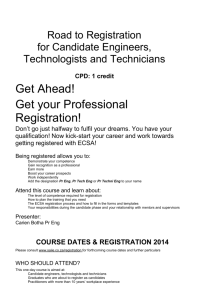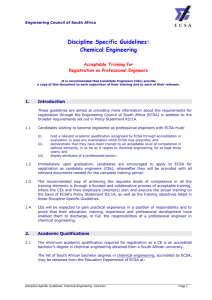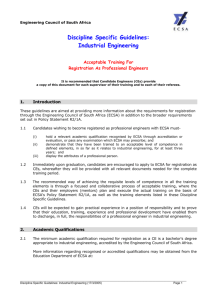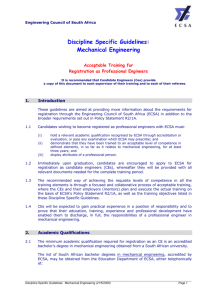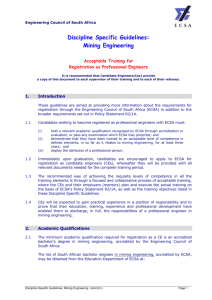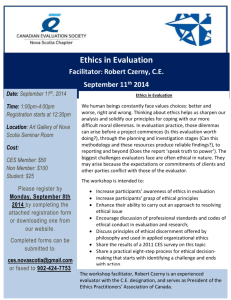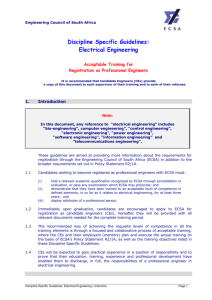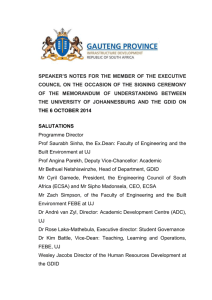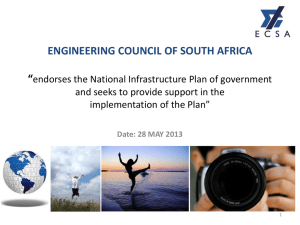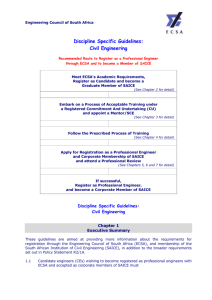Discipline Specific Guidelines: Metallurgical Engineering
advertisement
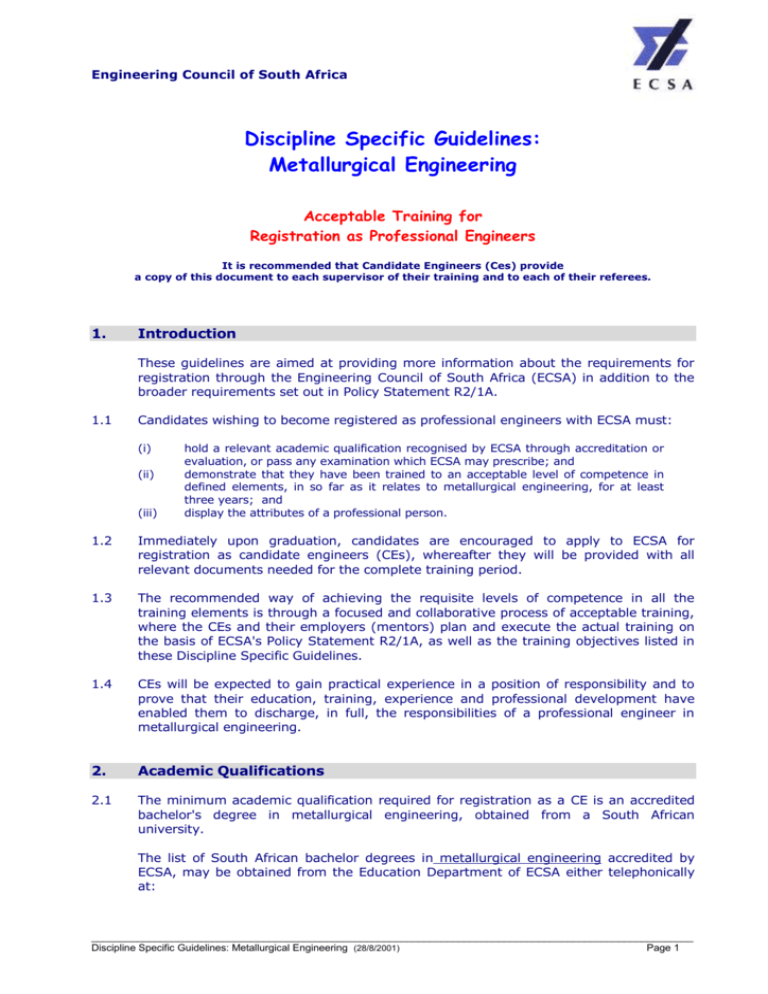
Engineering Council of South Africa Discipline Specific Guidelines: Metallurgical Engineering Acceptable Training for Registration as Professional Engineers It is recommended that Candidate Engineers (Ces) provide a copy of this document to each supervisor of their training and to each of their referees. 1. Introduction These guidelines are aimed at providing more information about the requirements for registration through the Engineering Council of South Africa (ECSA) in addition to the broader requirements set out in Policy Statement R2/1A. 1.1 Candidates wishing to become registered as professional engineers with ECSA must: (i) (ii) (iii) hold a relevant academic qualification recognised by ECSA through accreditation or evaluation, or pass any examination which ECSA may prescribe; and demonstrate that they have been trained to an acceptable level of competence in defined elements, in so far as it relates to metallurgical engineering, for at least three years; and display the attributes of a professional person. 1.2 Immediately upon graduation, candidates are encouraged to apply to ECSA for registration as candidate engineers (CEs), whereafter they will be provided with all relevant documents needed for the complete training period. 1.3 The recommended way of achieving the requisite levels of competence in all the training elements is through a focused and collaborative process of acceptable training, where the CEs and their employers (mentors) plan and execute the actual training on the basis of ECSA's Policy Statement R2/1A, as well as the training objectives listed in these Discipline Specific Guidelines. 1.4 CEs will be expected to gain practical experience in a position of responsibility and to prove that their education, training, experience and professional development have enabled them to discharge, in full, the responsibilities of a professional engineer in metallurgical engineering. 2. Academic Qualifications 2.1 The minimum academic qualification required for registration as a CE is an accredited bachelor's degree in metallurgical engineering, obtained from a South African university. The list of South African bachelor degrees in metallurgical engineering accredited by ECSA, may be obtained from the Education Department of ECSA either telephonically at: _________________________________________________________________________________________________________ Discipline Specific Guidelines: Metallurgical Engineering (28/8/2001) Page 1 Tel: Fax: E-mail: Web: (011) 607-9500 (011) 622-9295 engineer@ecsa.co.za www.ecsa.co.za or in writing at: Private Bag X691 Bruma 2026 2.2 Persons who have graduated from a university not accredited by ECSA will be assessed individually on merit. If their qualifications are evaluated as being at least equivalent to an accredited South African degree, candidates will be eligible for registration as CEs and could then follow the formal route to registration as professional engineers. 2.3 Persons whose qualifications are not accredited or recognised by ECSA may follow an alternative route to meet the academic requirements for registration as CEs. Candidates must apply to ECSA and obtain the necessary information on the procedure to be followed. 2.4 Those who meet ECSA's academic requirements should register as CEs without delay. Application forms can be obtained from ECSA. CEs must, from the outset, also obtain copies of the application form for registration as professional engineers. 3. Training and Professional Development under a Commitment and Undertaking (CU), and Mentorship Commitment and Undertaking (CU) 3.1 CEs must persuade their employers to register a Commitment and Undertaking with ECSA, namely that they will structure the training of, and actually train, their CEs, in accordance with the requirements of ECSA's Policy Statement R2/1A as well as the requirements set out in these Discipline Specific Guidelines. Each CU will be allocated a permanent registration number, which should be quoted by all CEs when applying for registration as professional engineers. 3.2 Employers must, at the same time, submit the name(s) of a mentor(s) from within the organisation (see § 3.4 below) or, if an internal mentor is not available, the name of an external mentor (see § 3.5 below) to guide CEs through the required process of training. A CU will not be registered by ECSA unless the name of at least one mentor (internal or external) is provided. Mentorship and Supervision 3.3 ECSA and the Institute of Mining and Metallurgy (SAIMM) will jointly maintain a list of internal and external mentors. A mentor must be registered as a professional engineer. Council will only in exceptional cases consider the listing of experienced and mature professional engineering technologists, professional certificated engineers, or professional engineering technicians, upon application and motivation by the organisation/mentor concerned. These mentors will be deemed not only to be capable of fulfilling their functions in a professional manner but also as being committed to advising and guiding their CEs in their professional development. 3.4 It is STRONGLY RECOMMENDED that all CEs should have a mentor who is working in the same organisation as the CE. 3.5 If a mentor is not available internally in the organisation, a list of external mentors can be obtained from ECSA or SAIMM. It will be expected of employers who make use of the services of external mentors to create an environment in which such mentors can feel free to make recommendations in the reasonable knowledge that their recommendations will be given sympathetic consideration. _________________________________________________________________________________________________________ Discipline Specific Guidelines: Metallurgical Engineering (28/8/2001) Page 2 3.6 It will be expected of all mentors to become fully conversant with their functions and responsibilities referred to in Policy Statement R2/1A and guidelines issued by ECSA from time to time, to conduct regular discussions with their CEs and to assess their progress in accordance with the guidelines set out in Policy Statement R2/1A and these Discipline Specific Guidelines. Since the effectiveness of mentors will be monitored continuously, Council will attach much value to the opinion of "the conscientious mentor" as to the registrability (or otherwise) of their CEs. 3.7 It is not expected of mentors to take responsibility for the day-to-day supervision and training of CEs. Mentors/employers should do everything in their power to ensure that competent persons, preferably registered with ECSA, are available to oversee this function as supervisors. 4. General 4.1 Training reports, which must be updated regularly, form an essential part of the monitoring process, and these reports must be filled in on the correct forms (Forms A2.1 and A2.2) of the application form. These forms should be obtained from ECSA as soon as the CEs start their training. 4.2 It is a requirement that CEs who are aspiring to become professional engineers should, with the assistance of their mentors, achieve their training objectives by structuring their training in such a way as to cover the various elements of training referred to in Policy Statement R2/1A and these Discipline Specific Guidelines. 4.3 The rate at which CEs progress through their training is determined by themselves, their mentors and other factors, such as the state of the economy and availability of training opportunities. 4.4 Where CEs, training under a CU decide to change employers, they should ensure that they continue their training under another CU registered with ECSA by their new employers. CEs should also ensure that their new employers provide mentors to guide them through the remainder of their training period and to take over where the previous mentor ended. It may even be advisable to retain the previous mentor, if this is at all practicable. 4.5 Once all the objectives have been achieved to the satisfaction of the mentor, CEs should, in principle be registerable, and could then apply for registration as a professional engineer. Depending on the circumstances, CEs may expect to take a minimum of three years to achieve acceptable competence in all the prescribed elements. 4.6 Regardless of whether or not CEs train under a CU, it is recommended that they strive to participate in a process of continuing learning. This concept includes continuing education and professional development. 4.7 Continuing learning may include the attending of courses, technical conferences, seminars, symposia, organised site visits, as well as meetings of professional bodies and self-study. The process of continuing learning should achieve a balance between technical content and managerial/professional aspects. 4.8 The mentors of CEs should, on a consultative basis, suggest suitable continuing learning programmes. 4.9 SAIMM and educational institutions may be able to assist in advising on courses which are available. _________________________________________________________________________________________________________ Discipline Specific Guidelines: Metallurgical Engineering (28/8/2001) Page 3 4.10 It will be to the advantage of CEs when applying for registration as professional engineers if they can demonstrate their participation in a process of continuing learning. 5. Professional Attributes The following attributes are considered common to all professional engineers and the requirements for these attributes are designed to ensure that CEs acquire competence with respect to professional responsibility in decision making, engineering judgement, leadership, communication and an appreciation of their own professional and working environments. 5.1 Professional Responsibility CEs must ensure that their work reaches a level of responsibility commensurate with that which ECSA would normally expect of an engineer with three years post-graduate experience, both in terms of the type and level of work being performed. This means that responsibility for directing personnel, money and materials must be taken during the execution of a project, or part of a project. When applying for registration as a professional engineer, CEs must demonstrate their ability to work satisfactorily on their own, that they have taken responsibility and, in having done so, achieved a satisfactory outcome. 5.2 Engineering judgement displayed in practical application When applying for registration as professional engineers, CEs must demonstrate that their engineering work required them to – 5.3 exercise independent technical judgement, combining their experience and application of engineering principles; accept responsibility for such decisions; and understand and take into account financial, economic, commercial and statutory considerations. Communications Skills CEs must develop the ability to communicate lucidly, accurately and with confidence. ECSA will base its assessment of CEs communication skills on the quality of the application presented. 5.4 Professional Environment CEs must, when reporting to their mentors on a regular basis, and in discussions with them, demonstrate that they have: a general understanding of engineering procedures applicable to their discipline of engineering; a general knowledge of legislation which has a bearing on the practice of engineering in South Africa, with a detailed knowledge of the important sections of the Engineering Profession Act, 2000 (Act 46 of 2000) and the Acts and Regulations applicable to their specific discipline of engineering; an understanding of the Code of Professional Conduct applicable to registered persons; an understanding of the purpose of and relationship between the various organisations involved in their discipline of engineering; and full familiarity with the requirements for registration set out in Policy Statement R2/1A as well as these Discipline Specific Guidelines. _________________________________________________________________________________________________________ Discipline Specific Guidelines: Metallurgical Engineering (28/8/2001) Page 4 6. Discipline Specific Elements Since the metallurgical engineering industry encompasses a wide field of activity, ranging from extractive metallurgy to physical metallurgy, it is not realistic to expect that all training programmes should cover the same field. However, it is recognised that a metallurgical engineer is usually employed in an organisation operating in one or more of the following fields: Metallurgical Plant Operation Specification, Design, Erection, and Commissioning of Metallurgical Plants Research, Development and Technology transfer The CE should have sound training in at least one of these fields and insight in preferably all three fields. Details of the type of training recommended in each of the fields are given below. For each field, the indicated training is regarded as representing a well-balanced programme, but it is acceptable if particular emphasis is placed on certain aspects, depending on the requirements of the employer and the particular aptitude of the CE. 6.1 Plant Operation It should be mentioned that one of the most useful ways in which the CE can gain experience is to be a member of a team responsible for the commissioning of a new or modified plant. Routine operation of existing plants will be considered as sufficient training, provided that as many of the following facets as possible are covered, with emphasis being placed on those that are particularly relevant to the operation: 6.1.1 Measurement and analysis of performance data; 6.1.2 Material and energy balances; 6.1.3 Process plant operation, especially with direct and increasing responsibility for certain sections of the plant; 6.1.4 Quality control in respect of measurement and specifications; 6.1.5 Plant records and operating costs; 6.1.6 The selection and application of instrumentation; 6.1.7 Optimization and control of the process to improve performance; 6.1.8 The principles of industrial engineering practice, including the critical study of work methods and the development of more effective techniques for recognizing real and significant problems and how to solve them; 6.1.9 Safety, and the acceptance of the principle that an engineer may not endanger the life and limb of the public through negligence; 6.1.10 Inter-relationships between engineering personnel and management, and between the members of the engineering team; 6.1.11 The impact that the operation may have on the environment; 6.1.12 Involvement in sound financial business concepts ranging from budgeting to feasibility studies; _________________________________________________________________________________________________________ Discipline Specific Guidelines: Metallurgical Engineering (28/8/2001) Page 5 6.1.13 6.2 Implementation and periodic review of sound labour relation process. Specification, Design, Erection and Commissioning of Plants and Components Training in this field should contain elements of each of the following four sub-sections: 6.2.1 Process Plant Development - laboratory, pilot, or full-scale plant work primarily aimed at obtaining engineering data for the specification and design of new metallurgical plants or the improvement of existing plants; 6.2.2 Plant Design - preparation of flow sheets and material and energy balances, appreciation of the operation of a drawing office and an engineering purchasing office, checking of working drawings for suitability with respect to the particular metallurgical operation, specification, design and selection of equipment, and service requirements, consideration of the design with regard to materials used, economics, instrumentation, quality control, logistics, safety, acceptable operation conditions, spillage management and the effect on the environment; 6.2.3 Plant Fabrication - a sound working knowledge of the inherent problems of construction, including working, cutting, shaping, machining, and joining of metals, the selection of optimum materials for construction (including surface treatment specifications), the supervision of plant erection, and erection programming; 6.2.4 Commissioning - measurement and analysis of actual performance data versus design parameters, responsibility for performance of the plant, optimization of plant performance, review of all safety standards, operability of the plant, sound labour relations and practices and managerial aspects. 6.3 Research, Development and Technology Transfer Research and Development would include any of the following areas: Minerals engineering Hydro-metallurgical Pyro-metallurgical engineering Materials engineering In a country endowed with such a variety and quantity of mineral resources, it is essential and inevitable that a proportion of the graduate metallurgical engineers will be employed in research and development. Experience should be gained in as many of the following facets of research and development as possible: 6.3.1 Develop a clear understanding of the problem/opportunity to be investigated by conducting a critical analysis of the literature and other relevant information, and assembling of the documentation on the subject in an organised manner; 6.3.2 Motivation, planning and design of the research project and its associated equipment and/or plant; 6.3.3 Theoretical or paper investigations; 6.3.4 Laboratory-scale investigation; 6.3.5 Investigations on a pilot plant and/or industrial plant scale; _________________________________________________________________________________________________________ Discipline Specific Guidelines: Metallurgical Engineering (28/8/2001) Page 6 6.3.6 Interpretation of results, and ensuring that results are meaningful and have been correctly obtained in accordance with scientific principles; 6.3.7 Data processing and analysis; 6.3.8 Studies of technical and economic feasibility; 6.3.9 Compilation of the results into a report and presentation of verbal reports; 6.3.10 Safety aspects with respect to the handling of chemicals and isotopes, and selection of instrumentation and equipment; 6.3.11 Spillage management and the effect on the environment; 6.3.12 Operational staff training and acceptable operating conditions; 6.3.13 Technology transfer to ensure that the maximum benefit is obtained from the research and development effort. 6.4 Lectureship Lecturers are often involved in the mentoring of CEs as well as in research, in engineering faculties, and as such make a valuable contribution to the training of future engineers. However, to be able to become a professional engineer the lecturer must become involved in the application of engineering knowledge by way of applied research and consulting work under the supervision of a professional engineer. Experience should be obtained in as many of the areas listed in paragraph 6.3 as possible. Since this will usually be undertaken on a part time basis, a period of 5 years of such training will be required for registration. However, should individuals consider that their experience is adequate after 3 years, the application should be considered by ECSA PAC Metallurgy on its own merits. 6.5 Human Resource Development The human resources aspect of the development of CEs should be addressed. Where possible, they should receive formal course training in this field, or, preferably be involved in the management of junior CEs and technicians. This will enhance the interpersonal relations and manpower management skills of the CE. 7. Specialist Training Applicants with an accredited or recognised engineering degree, having specialised in a narrow field (i.e. use of computers as an analytical tool) at an early stage might not comply with the "sufficient variety" requirement for registration. However, provided that the applicant's specialist knowledge is at least at the level of a master’s degree and provided that the applicant has demonstrated an ability, at a professional level, to identify engineering problems, and to produce solutions which can be satisfactorily implemented, a degree of trade-off may be acceptable in assessing the experience. Where an applicant's experience is judged to be in a narrow specialist field, a minimum of five years' experience after obtaining the bachelor degree in engineering will be required, but each application will be considered on merit. _________________________________________________________________________________________________________ Discipline Specific Guidelines: Metallurgical Engineering (28/8/2001) Page 7
